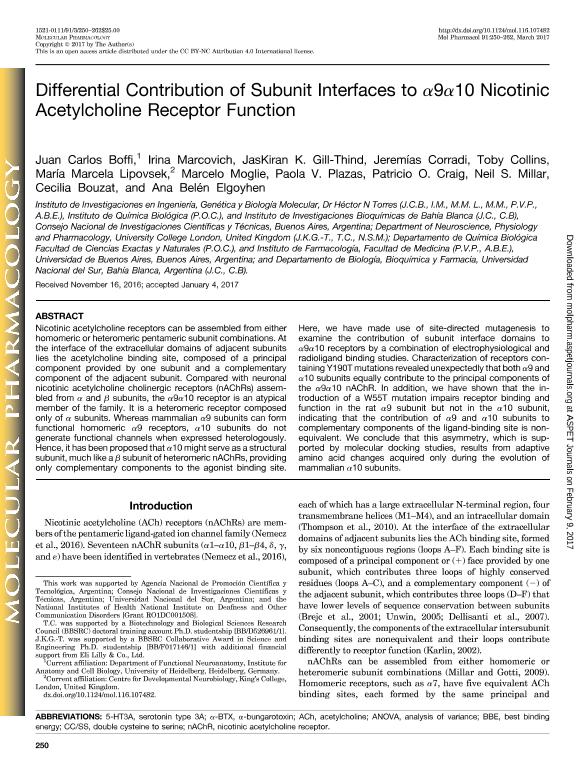Artículo
Differential Contribution of Subunit Interfaces to α 9 α 10 Nicotinic Acetylcholine Receptor Function
Boffi, Juan Carlos ; Marcovich, Irina
; Marcovich, Irina ; Gill Thind, JasKiran K.; Corradi, Jeremias
; Gill Thind, JasKiran K.; Corradi, Jeremias ; Collins, Toby; Lipovsek, Maria Marcela
; Collins, Toby; Lipovsek, Maria Marcela ; Moglie, Marcelo Javier
; Moglie, Marcelo Javier ; Plazas, Paola Viviana
; Plazas, Paola Viviana ; Craig, Patricio Oliver
; Craig, Patricio Oliver ; Millar, Neil S.; Bouzat, Cecilia Beatriz
; Millar, Neil S.; Bouzat, Cecilia Beatriz ; Elgoyhen, Ana Belen
; Elgoyhen, Ana Belen
 ; Marcovich, Irina
; Marcovich, Irina ; Gill Thind, JasKiran K.; Corradi, Jeremias
; Gill Thind, JasKiran K.; Corradi, Jeremias ; Collins, Toby; Lipovsek, Maria Marcela
; Collins, Toby; Lipovsek, Maria Marcela ; Moglie, Marcelo Javier
; Moglie, Marcelo Javier ; Plazas, Paola Viviana
; Plazas, Paola Viviana ; Craig, Patricio Oliver
; Craig, Patricio Oliver ; Millar, Neil S.; Bouzat, Cecilia Beatriz
; Millar, Neil S.; Bouzat, Cecilia Beatriz ; Elgoyhen, Ana Belen
; Elgoyhen, Ana Belen
Fecha de publicación:
03/2017
Editorial:
American Society for Pharmacology and Experimental Therapeutics
Revista:
Molecular Pharmacology
ISSN:
0026-895X
Idioma:
Inglés
Tipo de recurso:
Artículo publicado
Clasificación temática:
Resumen
Nicotinic acetylcholine receptors can be assembled from either homomeric or heteromeric pentameric subunit combinations. At the interface of the extracellular domains of adjacent subunits lies the acetylcholine binding site, composed of a principal component provided by one subunit and a complementary component of the adjacent subunit. Compared with neuronal nicotinic acetylcholine cholinergic receptors (nAChRs) assembled from α and β subunits, the α9α10 receptor is an atypical member of the family. It is a heteromeric receptor composed only of α subunits. Whereas mammalian α9 subunits can form functional homomeric α9 receptors, α10 subunits do not generate functional channels when expressed heterologously. Hence, it has been proposed that α10 might serve as a structural subunit, much like a β subunit of heteromeric nAChRs, providing only complementary components to the agonist binding site. Here, we have made use of site-directed mutagenesis to examine the contribution of subunit interface domains to α9α10 receptors by a combination of electrophysiological and radioligand binding studies. Characterization of receptors containing Y190T mutations revealed unexpectedly that both α9 and α10 subunits equally contribute to the principal components of the α9α10 nAChR. In addition, we have shown that the introduction of a W55T mutation impairs receptor binding and function in the rat α9 subunit but not in the α10 subunit, indicating that the contribution of α9 and α10 subunits to complementary components of the ligand-binding site is nonequivalent. We conclude that this asymmetry, which is supported by molecular docking studies, results from adaptive amino acid changes acquired only during the evolution of mammalian α10 subunits.
Archivos asociados
Licencia
Identificadores
Colecciones
Articulos(INGEBI)
Articulos de INST.DE INVEST.EN ING.GENETICA Y BIOL.MOLECULAR "DR. HECTOR N TORRES"
Articulos de INST.DE INVEST.EN ING.GENETICA Y BIOL.MOLECULAR "DR. HECTOR N TORRES"
Articulos(INIBIBB)
Articulos de INST.DE INVEST.BIOQUIMICAS BAHIA BLANCA (I)
Articulos de INST.DE INVEST.BIOQUIMICAS BAHIA BLANCA (I)
Articulos(IQUIBICEN)
Articulos de INSTITUTO DE QUIMICA BIOLOGICA DE LA FACULTAD DE CS. EXACTAS Y NATURALES
Articulos de INSTITUTO DE QUIMICA BIOLOGICA DE LA FACULTAD DE CS. EXACTAS Y NATURALES
Citación
Boffi, Juan Carlos; Marcovich, Irina; Gill Thind, JasKiran K.; Corradi, Jeremias; Collins, Toby; et al.; Differential Contribution of Subunit Interfaces to α 9 α 10 Nicotinic Acetylcholine Receptor Function; American Society for Pharmacology and Experimental Therapeutics; Molecular Pharmacology; 91; 3; 3-2017; 250-262
Compartir
Altmétricas



